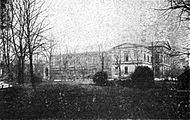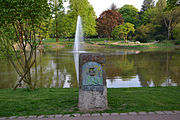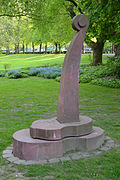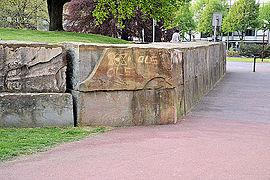Stadtgarten Essen
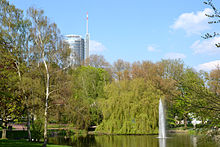
The Stadtgarten Essen is Essen's oldest publicly accessible green area. It is located south of Essen Central Station in the Südviertel district , between the Aalto Theater , the Philharmonie and the adjacent Rüttenscheid district .
The beginnings of the park go back to the year 1859. In 1877 the Bürgerpark became the first public park in Essen to become municipal property. It has been called the Stadtgarten since 1881.
history
Beginnings
As early as 1859, a green area was built near Huyssenallee in the south of the city on an area previously used for agriculture. A quarry, now filled with water, was also located here, from whose stones the Essen city wall was once built. The landscape architect Christian Schaumburg , who works in Hanover, was commissioned to design the green area after Peter Joseph Lenné had previously refused. The work was carried out by the Essen-based art gardener Karl Böhnert , whose house with front garden and exhibition room was on Kettwiger Strasse where the Kaufhof department store is today. At the time of industrialization, the rapidly increasing number of hard coal mines and the rapidly expanding steel industry of Friedrich Krupp AG , the green area should serve as a counterpoint to the recreation of the population. The rising upper class wanted, as was customary at the time, to demonstrate its economic prosperity and gain social prestige.
In 1863 the citizens of Essen founded the Essen non-profit public limited company for the realization of a city garden south of the old town and to finance the construction of an event hall in the Volksgarten. Friedrich Hammacher played a key role in this, and on October 5, 1888, on the 25th anniversary of the city garden, he was made an honorary citizen of the city of Essen.
On June 23, 1864, the foundation stone was laid for the Stadtgartensaal : a half-timbered building with a large ballroom, which was supplemented by a simple restoration building in two-storey solid construction. This building was demolished in the summer of 1901 due to increased demands and the hall was built in the same place .
“Our city has shed the agricultural character it had 25 years ago. The chimneys protrude everywhere, causing the mass transports of coal, iron stone and building materials to an often unbearable level of dust and dirt. In the area around the city there are only a few small sections of trees that offer shade. For visitors to such cities in particular, public gardens are an urgent need, the lungs of the city, as the English say. For us, shady, healthy meeting points are happy respirators of social well-being. "
In 1877 the park, which was 2.7 hectares in size, was the first park to be owned by the municipality after the stock corporation had financial problems and the city had bought all its shares. This makes the city garden, which has been known since 1881, the oldest publicly accessible green space in the city. Visiting the city garden was free of charge. A fee of 20 pfennigs was only charged for events. Under the direction of the Essen city gardener Heinrich Stefen , the green area was expanded to a size of 7.6 hectares in 1888, as the previous area became too small for the increased flow of visitors.
The city garden in the 20th century
In 1904 the new hall was completed. The now twelve hectare city garden was the most important green area in the city until the 1920s. Then the Grugapark followed as a competitor.
The relief image Schmied von Essen , which was created based on a design by the sculptor Ludwig Nick, was located in the Stadtgarten after the First World War until 1934. The figure was originally part of a nail figure unveiled on July 25, 1915 on the northern forecourt of the main train station . Finally it was brought to Grugapark in 1934, where it was bombed during World War II . During the Second World War, the city garden suffered severe destruction, which meant that it had to be rebuilt. The hall building was also destroyed in 1943 and rebuilt in different ways from 1949 to 1954. After several renovations, today's Philharmonie Essen is located in this hall building .
To the east of the hall and south of the not yet existing but planned Aalto Theater, construction began in 1969 on an underground station, including a parking, repair and maintenance facility under the city garden. The route leads from the Essen Hauptbahnhof underground station along under Huyssenallee, and turns with meter-gauge tracks to the southeast to the Stadtgarten. In the two-storey building, the subway station, possibly called the opera house or music theater , was to be built on the upper level , and below that the room for vehicle maintenance and parking. Further plans that provided for a continuation of the line to Kray were not implemented, so that the tunnel ends at the station under the city garden, which was never used as a train station.
In the 1980s, the city garden lost a few hectares in area due to the construction of the Sheraton Hotel in the west and the Aalto Theater in the north.
Today's park
With 6.87 hectares today, the Essen City Garden is the largest green space in the city center. Between some lawns it offers older trees, two playgrounds and a central pond with a fountain.
From 2004 renovations and modernizations took place in the city garden, and the Philharmonie moved into the hall. In addition, in 2006 the sealed area of a 2,400 square meter depot was redesigned into a green area. Finally, in 2008, paths and park benches were renewed, playgrounds redesigned and redesigned and the attractiveness of the pond area improved with new recreational opportunities. 1820 tons of mud were removed from the pond itself and the bank replanted. There was also a new, twelve-meter-high water fountain, which is illuminated by eight underwater spotlights. All of these measures were completed in October 2008. They took place with the support of the labor market project as part of the urban development program ESSEN.Neue Weg zum Wasser .
At the beginning of 2018, 12,000 euros were invested in the city garden, of which 34 new park benches were installed. In addition, in some cases new paths were laid and 23 new deciduous trees were planted after Pentecost Storm Ela destroyed 30 large deciduous trees in 2014.
Art in the city garden
In addition, some works of art have been set up in the city garden over the years. The oldest sculpture from 1905 is the fairy by Wilhelm Nida-Rümelin , which was originally intended to be installed as Aphrodite for a fountain in the foyer of the hall. It was dismantled at the beginning of 2016, given for restoration and is to be put up again with a new anchorage in the summer of the year. The location for a reciting or free speaking person was set up in 1987 by Wolfgang Liesen . The column, found in the rubble in 1983, appears to have broken off the base, sunk into the ground, and installed so that you can position yourself on the base without speaking. Of the Erdmäulern by Guido Hoffmann-Flick were four in total - one each mineral, vegetable, animal and human - set up by the landscape architect Ulrich Falke on 1994 landscaped playground.
The three really great minds of the artist Thomas Schütte have stood in front of the attached pavilion on the hall since 2004. The almost four meters high bronze sculptures, weighing tons, have risen to a value of around nine million euros, so that the Essen art collector and patron Thomas Olbricht decided, together with the city of Essen, to dismantle his loan for fear of metal theft. The removal took place on February 18, 2016, with a crane tearing off a figure's head. The damage was repairable. On July 19, 2019, the sculpture group Mann im Wind I, II, III was set up at the same location as a 10-year loan from the artist Thomas Schütte. Previously, the bronze figures, each weighing around two tons and 3.5 meters high, were on view at an exhibition in Paris .
- Works of art in the city garden (chronological)
Wilhelm Nida-Rümelin - Fee (1905)
Max Bill - The Infinite Loop (1974), made of Tranåsgranit ; Inscription: The citizens of Essen as a gift from Ferrostaal AG in 1978
Stephan Huber - cello (1987)
Klaus Simon - five fingers of one hand, five walls to the pentagram (1987)
Ulrich Rückriem - Obelisk (1987), made of dolomite rock
Wolfgang Liesen - Location for a Hands-Free Person (1987)
Thomas Schütte - Great Minds (1998-2004), since 2016 dismantled
Regular events
The Boule-Pétanque-Club Essen-Stadtgarten e. V. organizes a boules tournament every Sunday .
The city garden serves as the starting line-up for the Tour de Rü (Rü for Rüttenscheider Strasse) vintage car tour, which has been taking place since 2004 .
The Park Sounds have been taking place in June every year since 2011 (with the exception of 2014, due to the Pentecost Storm Ela ), where experimental electronic sounds are offered.
literature
- Wolfgang Gaida, Helmut Grothe: From the Kaisergarten to the Revierpark . Pomp, Bottrop, Essen 1997, ISBN 978-3-89355-162-0 , pp. 93-96 .
Web links
- Stadtgarten Essen at www.essen.de ; accessed on April 18, 2018
- City garden views on www.essen.de ; accessed on April 18, 2018
Individual evidence
- ^ Official guide through the Great Ruhrland Horticultural Exhibition Gruga p. 36; ed. from the exhibition management 1929 digitalization of the ULB Düsseldorf
- ^ Hugo Rieth: Essen in old views, Volume 1 . 3. Edition. Zaltbommel, Netherlands 1978.
- ^ A b Thomas Dupke: Essen. History of a city . Ed .: Ulrich Borsdorf. Peter Pomp Verlag, Bottrop, Essen 2002, ISBN 3-89355-236-7 , p. 312 .
- ^ Portrait of Friedrich Hammacher on essen.de ; accessed on April 18, 2018
- ↑ a b Hall and Philharmonic Hall. (PDF; 949 kB) In: List of monuments of the city of Essen. Retrieved April 18, 2018 .
- ^ Hugo Rieth: Essen in old views . 7th edition. tape 2 . Zaltbommel, Netherlands 1991, ISBN 90-288-3097-9 .
- ↑ DerWesten.de of December 2, 2014: There has been a ghost underground station behind the Aalto Theater for 45 years ; accessed on April 18, 2018
- ↑ Essen.de: Brief portrait of the district of the Südviertel ; last viewed on June 28, 2016 (page changed today)
- ↑ Press release Arbeit und Bildung Essen Gesellschaft mbH (ABEG) from October 30, 2008: The city garden is ready.
- ↑ Stadtgarten: Essen's oldest park gets 34 new benches ; In: Westdeutsche Allgemeine Zeitung from April 15, 2018; accessed on April 18, 2018
- ↑ Derwesten.de of April 2, 2016: Stadtgarten visitors miss the bronze fairy ; accessed on April 18, 2018
- ↑ Derwesten.de of February 18, 2016: artist regrets dismantling of sculptures at the Philharmonie ; accessed on April 18, 2018
- ↑ Press release of the city of Essen from July 19, 2019: New group of sculptures in the Essen city garden
- ^ BPC Essen-Stadtgarten e. V .; accessed on April 18, 2018
- ↑ Tour de Rü ; accessed on April 18, 2018
- ↑ Press release of the City of Essen in July 2015: Park Sounds in the Stadtgarten open the summer
Coordinates: 51 ° 26 ′ 40 ″ N , 7 ° 0 ′ 42 ″ E



